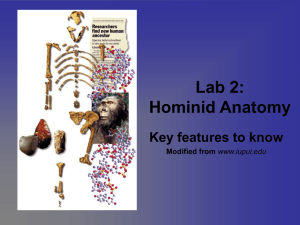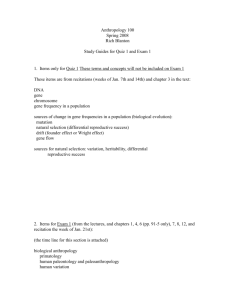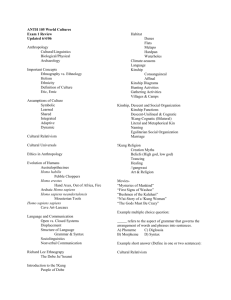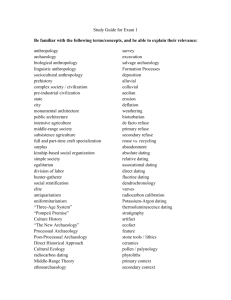Hominid Anatomy Key features to know Modified from
advertisement
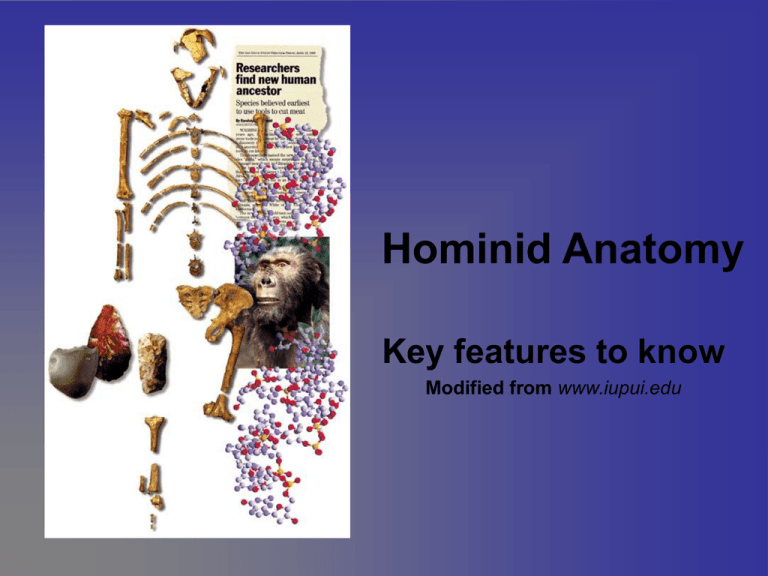
Hominid Anatomy Key features to know Modified from www.iupui.edu How does evolution explain complex organisms like humans? https://www.youtube.com/watch?v=oxgnlSbYLSc Erect posture Shape of spinal column Skeletal implications of bipedalism Location of foramen magnum Bipedal Locomotion Laetoli Footprints Chimp and human foot Femurs of upright walkers and ape Leg of ape Quadrupedal animals like apes, have femurs in which the ball joint, the part that joins the pelvis, sits directly over the inside of the knee. The angle subtended by the femur at the knee in quadrupedal walkers is less than that of bipedal walkers. Leg of Australopithecus afarensis This diagram shows the femur with the same shape and structure as that of modern humans, but it is a little shorter. It subtends the same angle at the knee as that of a modern human and the inner bump of the knee joint is larger than the outer one. This shows that this hominin was also a bipedal walker. Leg of modern human This modern Homo sapiens bone shows the structure of the femur of an upright walker or bipedal animal. The ball joint, the part that joins the pelvis, sits directly over the outside of the knee. The angle subtended by the femur at the knee in bipedal walkers is greater than that of quadrupedal walkers. This results in the inner bump of the knee joint being longer than the outer bump. Skeletal implications of bipedalism Pelvis, femur feet Skeletal implications of bipedalism Chimp vs. A. afarensis Knock-kneed walk Pongid Prognathism. (Line of greatest muscle force is shown in red.) Understanding Physical Anthropology and Archaeology, 8th ed., p. 245 Satittal crests and temporal muscle orientations. Hominid compared to pongid. (Line of greatest muscle force is shown in red.) Understanding Physical Anthropology and Archaeology, 8th ed., p. 245 Human and Ape Brains Humankind Emerging, 7th ed., p. 389 The brains develop in . . . • size • complexity • the ratio of brain weight to overall body weight Cranial Capacity Understanding Physical Anthropology and Archaeology, 8th ed., p. 234 Cranial Capacity & Vaulted Forehead Australopithecus afarensis Homo (sapiens?) neandthalensis Homo erectus Homo sapiens sapiens Teeth / Dental Arcade Monkey & Ape Canines Apes (and monkeys) still possess conical, dagger-like canines which project well beyond the surface of the opposite teeth. The gap is a diastema. Teeth of a male patas monkey. Understanding Physical Anthropology and Archaeology, 8th ed., p. 231 Molar Cusp Patterns plus-4 Y-5 Y-5 Example of early hominid fossil Y-5 cusp pattern molars Dental formulae Understanding Physical Anthropology and Archaeology, 8th ed., p. 125 Changes in dental arcade Proconsul heseloni 19 - 17 mya Homo erectus 500,000 - 300,000 y Modern Chimp Australopithecus africanus,2.8 - 2.3 mya Modern homo sapiens 100,000 ya to now Crests and other muscle attachments Crests and other muscle attachments zygomatic arch Mandible and chewing Muscle attachments Some Important Skull Features Modern human cranium. Understanding Physical Anthropology and Archaeology, 8th ed., p. 510 For a nearly complete look at skulls, click on the image above for the Australian National Museum’s web site. Be sure to look at Becoming Human, the Institute for Human Origins broadband documentary and web site.
